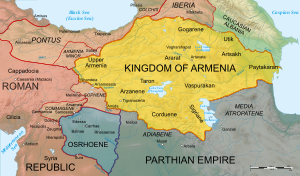Pacorus I
| Pacorus I 𐭐𐭊𐭅𐭓 | |
|---|---|
Arsacid dynasty | |
| Father | Orodes II |
| Religion | Zoroastrianism |
Pacorus I (also spelled Pakoros I; Parthian: 𐭐𐭊𐭅𐭓; died 38 BC) was a Parthian prince, who was the son and heir of Orodes II (r. 57–37 BC). The numismatist David Sellwood deduced that Pacorus ruled in c. 39 BC. It is uncertain whether Pacorus ruled alongside his father, or ruled independently. His wife was an unnamed Armenian princess, who was a sister of the Artaxiad king of Armenia, Artavasdes II (r. 55–34 BC).
Following the Parthian victory against the
Name
The name Pacorus is the
Biography

Pacorus was the eldest son and heir of
Following Crassus's defeat and death at Carrhae, the Parthians attempted to capture Roman-held territories in

After Syria was occupied by Pacorus's army, Labienus split from the main Parthian force to invade Anatolia while Pacorus and his commander Barzapharnes invaded the Roman Levant.[9] They subdued all settlements along the Mediterranean coast as far south as Ptolemais (modern Acre, Israel), with the exception of Tyre.[11] In Judea, the pro-Roman Jewish forces of high priest Hyrcanus II, Phasael, and Herod were defeated by the Parthians and their Jewish ally Antigonus II Mattathias (r. 40–37 BC); the latter was made king of Judea while Herod fled to his fort at Masada.[9]
Despite these successes, the Parthians were soon driven out of the Levant by a Roman counteroffensive.
The numismatist David Sellwood deduced that Pacorus ruled in c. 39 BC. It is uncertain whether Pacorus ruled alongside his father, or ruled independently.[3]
In literature
The medieval Muslim writer
References
- ^ a b Rapp 2014, p. 334.
- ^ Marciak 2017, p. 224.
- ^ a b Ellerbrock 2021, p. 43.
- ^ Olbrycht 2021.
- ^ Bivar 1983, pp. 55–56; Garthwaite 2005, p. 79; see also Brosius 2006, pp. 94–95 and Curtis 2007, pp. 12–13
- ^ Kennedy 1996, p. 80 asserts that permanent occupation was the obvious goal of the Parthians, especially after the cities of Roman Syria and even the Roman garrisons submitted to the Parthians and joined their cause.
- ^ Kennedy 1996, pp. 78–79; Bivar 1983, p. 56
- ^ Bivar 1983, pp. 56–57; Strugnell 2006, p. 243
- ^ a b c Bivar 1983, p. 57; Strugnell 2006, p. 244; Kennedy 1996, p. 80
- ^ Syme 1939, pp. 214–217
- ^ Bivar 1983, p. 57
- ^ a b Bivar 1983, pp. 57–58; Strugnell 2006, pp. 239, 245; Brosius 2006, p. 96; Kennedy 1996, p. 80
- ^ Bivar 1983, p. 58; Brosius 2006, p. 96; Kennedy 1996, pp. 80–81; see also Strugnell 2006, pp. 239, 245–246
- ^ Yarshater 1983, p. 475.
Sources
- ISBN 0-521-20092-X.
- Brosius, Maria (2006), The Persians: An Introduction, London & New York: Routledge, ISBN 978-0-415-32089-4
- ISSN 0068-1202.
- Ellerbrock, Uwe (2021). The Parthians: The Forgotten Empire. Oxford: Routledge. ISBN 978-0367481902.
- Garthwaite, Gene Ralph (2005), The Persians, Oxford & Carlton: Blackwell Publishing, Ltd., ISBN 978-1-55786-860-2
- ISBN 978-1-887829-18-2
- ISBN 978-9004350700.
- Olbrycht, Marek (2021). "Orodes II". In Yarshater, Ehsan (ed.). Encyclopædia Iranica, Online Edition. Encyclopædia Iranica Foundation.
- Rapp, Stephen H. (2014). The Sasanian World through Georgian Eyes: Caucasia and the Iranian Commonwealth in Late Antique Georgian Literature. Burlington, Vermont: Ashgate Publishing, Ltd. ISBN 978-1472425522.
- Strugnell, Emma (2006), "Ventidius' Parthian War: Rome's Forgotten Eastern Triumph", Acta Antiqua, 46 (3): 239–252,
- OCLC 1035928651
- ISBN 0-521-20092-X.
Further reading
- Shayegan, M. Rahim (2011). Arsacids and Sasanians: Political Ideology in Post-Hellenistic and Late Antique Persia. ISBN 978-0521766418.
